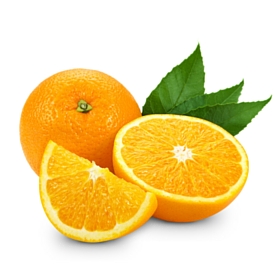Oranges

Once considered a delicacy and quite expensive, the orange holds the prominent position of the 3rd most popular fruit in the USA (just in case you are wondering, apples and bananas are in the first and second place). Like most citrus fruits, oranges most likely originated in Southeast Asia. We have Columbus to thank for introducing orange seeds and seedlings to the New World. At the time, oranges were mostly planted in Florida. Since 1910, Florida has held the title of the number-one citrus-growing state producing about 70% of the country’s oranges.
Americans consume most of their oranges in the form of juice. In fact, about 90% of the Florida’s orange crop is processed into orange juice. More than any other fruit, the orange is associated with–and valued for–its vitamin C content, and a single serving of juice provides 140% of the current suggested daily intake of vitamin C. Oranges have more to offer nutritionally than just this one nutrient. A small orange contains generous levels of folate (folic acid), potassium, and thiamin, as well as some calcium and magnesium. And if you choose to eat a whole orange instead of drinking a glass of juice, you’ll get the added benefit of dietary fiber.
At the market
Oranges are always picked when they are ripe. Choose ones that are firm, heavy for their size (they will be juiciest). The skin should be smooth. Thin-skinned oranges are juicier than thick-skinned varieties, and small- to medium-sized fruits are sweeter than the largest oranges.
Storage
Oranges keep for up to two weeks in the refrigerator. But they keep almost as well at room temperature, retaining nearly all of their vitamin content even after two weeks. They will also yield more juice if kept at room temperature.
Creative ideas to eat more oranges in your meals:
Freshly Squeezed: There’s not much better than fresh squeezed orange to wake up your morning. Get your kids involved by teaching them how to squeeze the oranges – even tiny toddler hands can do it.
Orange Pancakes: For a nice, fresh, eye- opening flavor, replace half of the liquid needed in your favorite pancake recipe for orange juice.
Orange Zested Muffins: Add 1-2 teaspoons of orange zest to a basic muffin mix. Dried cranberries and almonds taste excellent with orange flavor, so you can’t go wrong by adding a ½ a cup of each to the recipe too.
Citrus-y Spinach Salad: Add drained mandarin oranges (buy the kind in juice, not syrup), toasted almonds, chopped hard boiled egg, and thin slices of red onion to a mound of fresh baby spinach. Toss with a poppy seed or sesame ginger vinaigrette dressing.
Mediterranean Salsa: Combine 1 cup of orange sections or mandarin oranges (in juice), ½ cup green or black olives, and ¼ cup of thin sliced red onion with 1-2 tablespoons of olive oil and 1 tablespoon lime juice. Serve over fresh grilled fish. Garnish with chopped mint.
Summer is prime time for kabobs!
Orange Ginger Teriyaki Kabobs
- Add ½ cup of fresh squeezed orange juice and 1 inch of thinly sliced fresh ginger to your favorite teriyaki marinade.
- Cut an assortment of veggies, tofu and meats into 1-2 inch cubes/chunks and marinate: veggies/fish for 15 minutes and meats/tofu 1-4 hours (or overnight).
- Slide marinated foods onto the skewers alternating the flavors.
- Fire up the BBQ or a grill pan. Place the kabobs on the grill and cook until done, about 5-7 minutes. Turn a couple times during cooking and baste frequently with marinade.
- Green or Red Pepper
- Extra firm or baked tofu
- White or Green Onions
- Asparagus
- Whole mushrooms (especially Shitakes!)
- Zucchini and yellow squash
- Pineapple
- Cooked Chicken
- Firm fish (Swordfish, Tuna)
- Shrimp









